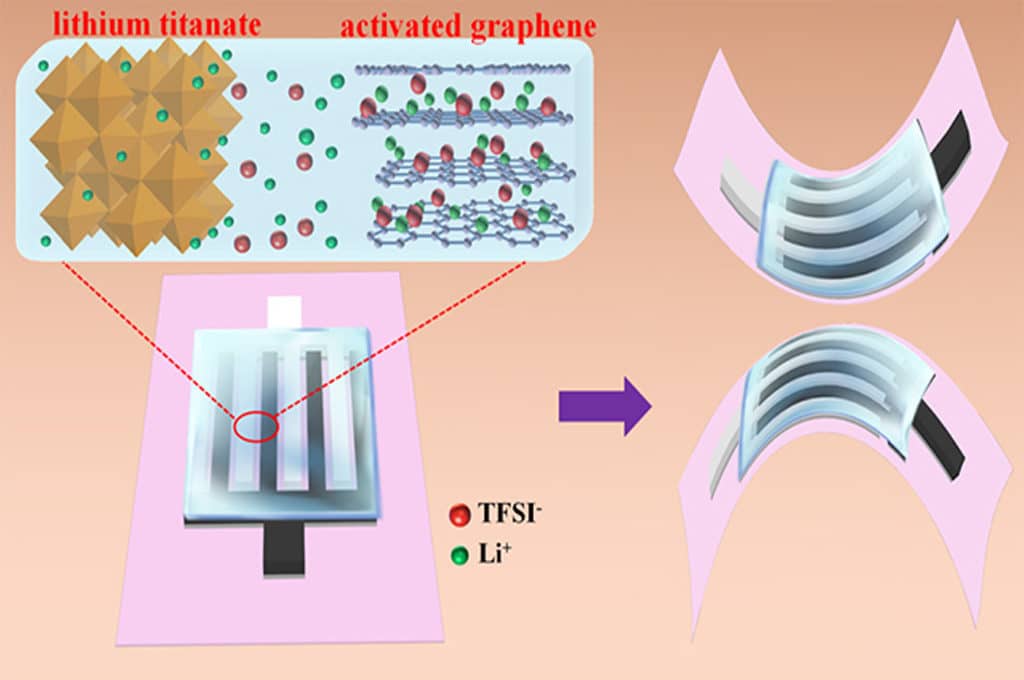Source: DICP news
A research team led by WU Zhongshuai and BAO Xinhe et al. from Dalian Institute of Chemical Physics of the Chinese Academy of Sciences, collaborated with HE Yanbing from Graduate School at Shenzhen of Tsinghua University, reported a new-type all-solid-state planar lithium ion micro-capacitors (LIMCs) with landmark volumetric energy density, superior thermal stability and safety at high temperature, outstanding mechanical flexibility, and exceptional integration of bipolar cells.
This LIMCs were based on interdigital patterned films of carbon-coated lithium titanate (LTO) nanospheres as anode, and activated graphene (AG) as cathode, using high-voltage ionogel as electrolyte. Their findings were published online in Energy & Environmental Science.
Portable and wearable electronics and micro-electro-mechanical systems, e.g., micro-robots and micro-sensors, are currently moving toward the integrated multi-functionality of on-chip, thin, lightweight and flexible features. This intensively stimulates the rapid development of the microscale electrochemical energy storage devices.
The emerging planar micro-supercapacitors (MSCs) constructed on single substrate possess the intriguing merits of high power density, free separator, and ultralong life span. Those advantages enable MSCs to become one highly-competitive miniaturized energy source. However, most reported MSCs still suffer from low volumetric energy density that can’t compete with lithium thin-film batteries. Also, MSCs are limited by poor high-temperature stability resulting from volatile electrolytes, unsatisfying flexibility and limited integration.
Lithium ion capacitors (LICs) represent a promising class of next-generation competitive power sources because they can simultaneously achieve high energy density and high power density to effectively bridge the gap between lithium ion batteries and supercapacitors. However, all the LICs reported have been constructed in a nonplanar device geometry, by sandwiching a polymer separator or solid-state electrolyte between two electrode-based substrates.
To solve the above problems, the scientists developed the interdigital LIMCs, which were fabricated via layer-by-layer mask-assisted deposition of graphene (EG) and electrode materials, without metal current collector, additive and polymer binder. The resulting patterns of sandwich-like electrode structures showed outstanding uniformity, mechanical flexibility, high electrical conductivity.
These electrode films with strong adhesion to the substrate are free of metal current collectors, conventional separator and polymer binder. Notably, all-solid-state LTO//AG-LIMCs delivered ultrahigh volumetric energy density of 53.5 mWh/cm3, which is threefold higher than those of AG//AG-MSCs (18.1 mWh/cm3) and lithium thin-film batteries, and superior to the reported MSCs so far.
Furthermore, LTO//AG-LIMCs exhibited superior cycling stability with 98.9% of capacitance retention after 6000 cycles, high-temperature electrochemical stability at 80 °C. Moreover, LTO//AG-LIMCs showed outstanding mechanical flexibility without performance degradation under various bending and twisting.
In addition, this finding is highly scalable for mass production of multiple flexible LTO//AG-LIMCs to modulate the output voltage and capacitance for integrated circuits. Therefore, they hold great potential for future flexible and wearable electronics.
The above work was supported by National Natural Science Foundation of China, National Key R&D Program of China, Natural Science Foundation of Liaoning
featured image: all-solid-state flexible planar Lithium Ion Micro-Capacitors; image credit: ZHENG Shuanghao
